
Gasoline Alley is a comic strip created by Frank King and distributed by Tribune Content Agency. It centers on the lives of patriarch Walt Wallet, his family, and residents in the town of Gasoline Alley, with storylines reflecting traditional American values.
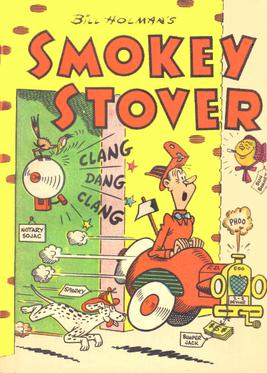
Smokey Stover is an American comic strip written and drawn by cartoonist Bill Holman from March 10, 1935, until he retired in 1972 and distributed through the Chicago Tribune. It features the misadventures of the titular fireman.

James Edward Murphy Jr. was a self-taught American cartoonist who is best known for his long-run family comic strip, Toots and Casper. His earliest strips, signed J.E. Murphy, had a crude awkward look, but as his cartooning improved, his full signature of Jimmy Murphy appeared.

A topper in comic strip parlance is a small secondary strip seen along with a larger Sunday strip. In the 1920s and 1930s, leading cartoonists were given full pages in the Sunday comics sections, allowing them to add smaller strips and single-panel cartoons to their page.

Smitty was a newspaper comic strip created in the early 1920s by Walter Berndt. Syndicated nationally by the Chicago Tribune New York News Syndicate, it ran from November 27, 1922, to 1974 and brought Berndt a Reuben Award in 1969.

Mickey Finn was an American comic strip created by cartoonist Lank Leonard, which was syndicated to newspapers from April 6, 1936 to September 10, 1977. The successful lighthearted strip struck a balance between comedy and drama. It was adapted to a 400-page Little Big Book and was reprinted in several comic book series throughout the 1930s and 1940s.
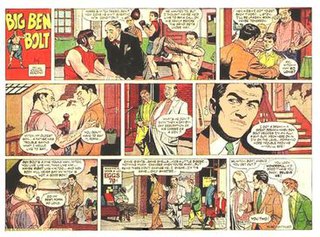
Big Ben Bolt is a comic strip that was syndicated from February 20, 1950 to April 15, 1978. It was drawn by John Cullen Murphy, written by Elliot Caplin, and distributed by King Features Syndicate. The strip followed the adventures of boxer and journalist Ben Bolt.

Reg'lar Fellers is a long-running newspaper comic strip adapted into a feature film, a radio series on the NBC Red Network, and two animated cartoons. Created by Gene Byrnes (1889–1974), the comic strip offered a humorous look at a gang of suburban children. Syndicated from 1917 to January 18, 1949, Byrnes' strip was collected into several books. Branding also extended to such items as baseball bats and breakfast cereal.
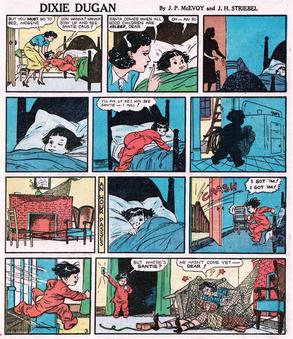
Dixie Dugan is best known as a long-running syndicated newspaper comic strip published from October 21, 1929 to October 8, 1966. The title character was originally modeled after 1920s film actress Louise Brooks and early stories followed Dixie's exploits as a Hollywood showgirl.

Little Jimmy, originally titled Jimmy, is a newspaper comic strip created by Jimmy Swinnerton. With a publication history from February 14, 1904, to April 27, 1958, it was one of the first continuing features and one of the longest running.

Tillie the Toiler is a newspaper comic strip created by cartoonist Russ Westover who initially worked on his concept of a flapper character in a strip he titled Rose of the Office. With a title change, it sold to King Features Syndicate which carried the strip from January 3, 1921, to March 15, 1959.

The Bungle Family is an American gag-a-day comic strip, created by Harry J. Tuthill, that first appeared in 1918. Originally titled Home, Sweet Home, it first appeared as part of a series of rotating strips in the New York Evening Mail. The strip ran until June 2, 1945.
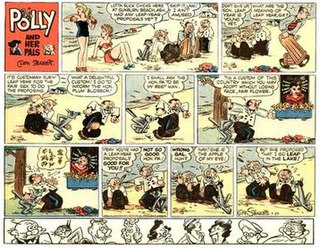
Polly and Her Pals is an American comic strip, created by cartoonist Cliff Sterrett, which ran from December 4, 1912, until December 7, 1958. It is regarded as one of the most graphically innovative strips of the 20th century. It debuted as Positive Polly on December 4, 1912, in William Randolph Hearst's newspapers, initially the New York Journal, and was later distributed by King Features Syndicate. The title changed to Polly and Her Pals on January 17, 1913.
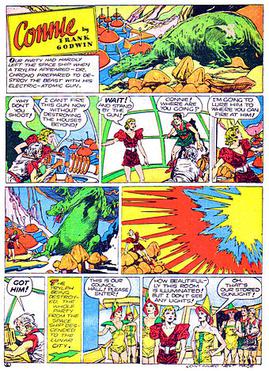
Connie is an American adventure comic strip created by the cartoonist Frank Godwin, who introduced a book illustration style to the comics page. The strip ran from 1927 to 1941 for the Ledger Syndicate. Connie debuted as a Sunday page on November 13, 1927. The strip was syndicated in France as Cora in the weekly paper Le Journal de Mickey.
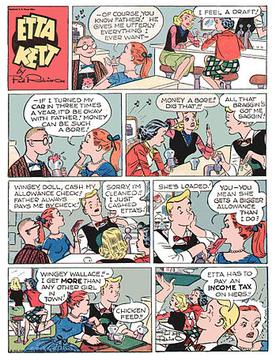
Etta Kett is a long-running comic strip created by Paul Robinson, which ran from December 7, 1925 to November 9, 1974.

Long Sam is an American comic strip created by Al Capp, writer-artist of Li'l Abner, and illustrated by Bob Lubbers. It was syndicated by United Feature Syndicate from May 31, 1954, to December 29, 1962. The strip was initially written by Capp, who soon turned the duties over to his brother, Elliot Caplin. Lubbers eventually assumed the writing duties himself in the strip's last few years.
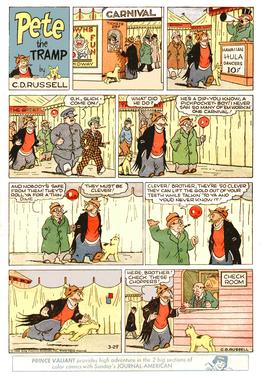
Pete the Tramp is an American comic strip by Clarence D. Russell (1895–1963) which was distributed by King Features Syndicate for more than three decades, from January 10, 1932 to December 22, 1963. Howard Eugene Wilson, in the Harvard Educational Review, described the strip's title character as "a hobo with a gentleman's instincts."

Room and Board is the title of two American comic strips. The first, created by Sals Bostwick, debuted on May 21, 1928. He drew it until his death in 1930, after which it was continued by cartoonists Brandon Walsh, Benbee, Darrell McClure, Dow Walling and Herman Thomas before coming to an end in 1932.

Alvah Posen was an American cartoonist on several comic strips, but he is best known for his 1933-1960 comic strip Sweeney & Son and as co-producer of the now-lost Marx Brothers film, Humor Risk (1921).
Little Mary Mixup was an American comic strip drawn by Robert Moore Brinkerhoff, which ran from January 2, 1918, to February 2, 1957.



















